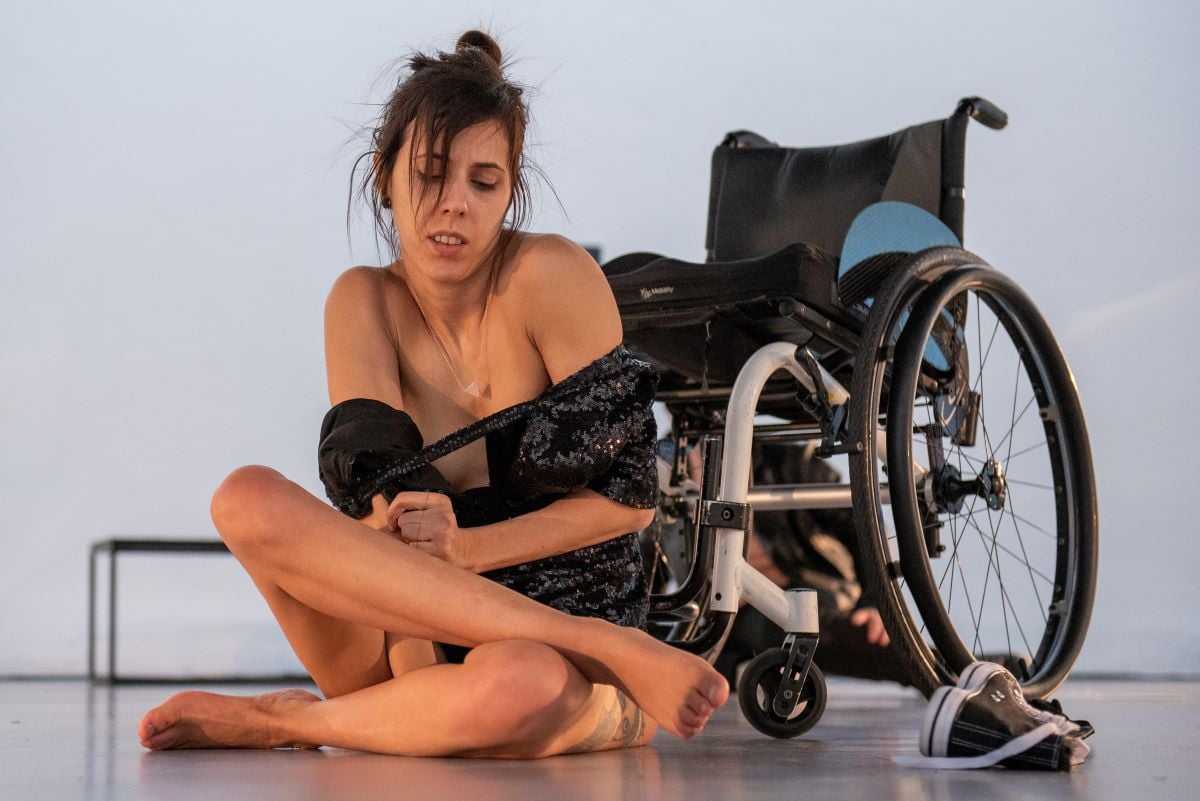
Diana Niepce performing in Pokaz Teatr21
Photo: Pawel Kuligowski
Understanding the needs of disabled artists
In the last in our series on widening participation, Diana Niepce writes: Two burnouts a year is not sustainable for anyone, but it’s a reality for disabled dancers. The sector needs to change.
My work is intensely physical. I’m a dancer and choreographer and, as anyone who works with their body knows, scheduling rest periods is crucial. You can’t continuously push yourself without facing the risks and consequences of exhaustion.
I have been known to work 14-hour days and, at times, have had two burnouts in a year. Physical work for any artist is intense, but the additional energy required to fight for basic rights as a disabled dancer is the tipping point.
In 2019, I created a work called 12 979 Days which involved the dancers being completely covered in glitter. And as everyone knows, glitter gets everywhere.
It was imperative that the dancers had showers before leaving the venue. Not only did we not want remnants of the show in our houses forever, the taxi drivers taking us home would not have thanked us.
A lack of access to basic facilties
As a wheelchair user, I need a special chair to be able to shower but the theatre I was working at didn’t have one. They asked all the theatres in the city and not one was able to provide this chair. Not one. That was when I realised that all wheelchair users who had previously performed in local theatres had not been provided with basic access to showering facilities.
For non-disabled performers, showering facilities are guaranteed. It is a standard requirement for theatres and venues to provide them with a space to wash. Apparently not for disabled performers.
This kind of experience is shockingly commonplace for disabled artists. Recently in the UK, award-winning disabled artist Jamie Hale publicly withdrew from the Les Enfants Terrible awards competition hosted at Greenwich Theatre as there was no access to toilets or even a dressing room for disabled artists.
There is an expectation that disabled people need to accept a lack of access to basic facilities if we want to work as artists and participate in the cultural sector.
In another case, I was due to perform. The day before, the venue informed me I shouldn’t come because it wasn’t accessible. It felt like an act of violence and discrimination against my body. It was clear I wasn’t welcome, but instead of the venue doing due diligence and ensuring access, I was made to feel I was the problem.
Transnational evidence
When such things happen, cultural venues often want to sweep it under the rug, hoping it will go unnoticed and artists won’t fight back. It is only recently that I have noticed small changes, but often it’s only when disabled artists get a bigger public following that venues get nervous about criticism and reputational damage.
Change shouldn’t be dependent on the popularity of artists if our success and ability to work is hindered by those very systems that need changing.
This week, Europe Beyond Access publishes the second part of it report, Time to Act: Two Years On, commissioned by British Council and produced by European cultural mobility organisation On The Move. It provides the first transnational evidence that lack of knowledge in the mainstream cultural sector is a key barrier preventing disabled artists from participating equally in the arts.
Currently there isn’t enough awareness or understanding of the needs of disabled artists, something we’ve known for a long time but now we have this international study to back it up.
Knowledge of disabled artists (very) poor
The first part of the research, published in 2021, found that more than half of arts workers rated their knowledge of disabled artists as poor or very poor. Around 1 in 6 had not seen any productions by disabled artists over a two-year period, and 48% noted their low confidence in the accessibility of their own artistic programmes for disabled artists.
This second part of the findings looks further into the specific details of how discrimination against disabled artists happens and it addresses what organisations and funders can do to level the playing field.
It’s clear that we need structural and institutional change to ensure we can access the same opportunities as non-disabled artists. Ableism in the arts is like the glitter in my show: it gets everywhere and is not so easy to get rid of.
Diana Niepce is a dancer and choreographer.
![]() www.aniepce.com/
www.aniepce.com/
This article is based on a podcast, Getting What You Need, produced by Europe Beyond Access as part of a new series of online toolkits for disabled artists, producers and funders.
Europe Beyond Access is an international programme co-funded by the Creative Europe programme of the European Commission which supports disabled artists to break the glass ceilings of the contemporary theatre and dance sectors.

Join the Discussion
You must be logged in to post a comment.